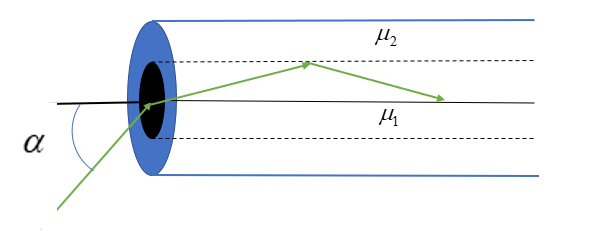
An optical fiber consists of core of ${\mu _1}$ surrounded by a cladding of ${\mu _2} < {\mu _1}$ A beam of light enters from air at an angle α with axis of fiber. The highest α for which ray can be traveled through fiber is

A. ${\cos ^{ - 1}}\sqrt {{\mu ^2}_1 - {\mu ^2}_2} $
B. ${\sin ^{ - 1}}\sqrt {{\mu ^2}_1 - {\mu ^2}_2} $
C. ${\sec ^{ - 1}}\sqrt {{\mu ^2}_1 - {\mu ^2}_2} $
D. ${\tan ^{ - 1}}\sqrt {{\mu ^2}_1 - {\mu ^2}_2} $
Answer
220.2k+ views
Hint: In this question we will be using the snell's law and basic trigonometric identities to solve and get the desired answer. When light travels from one medium to another, Snell's law is used to link the angle of incidence and angle of reflection with the refractive index of a medium.
Formula used:
$\dfrac{{\sin \alpha }}{{\sin r}} = {\mu _1}$
Complete step by step solution:
Refraction is the study of how light bends when it comes into contact with two media that have different refractive indices. As a result, the refractive indices of the two media may be related through the angle associated with incidence and refraction.
Snell’s law: The reciprocal of the ratio of the indices of refraction, or the ratio of phase velocities in the two media, is said to be identical to the ratio of the sines of the angles of incidence and refraction.
$\dfrac{{\sin \alpha }}{{\sin r}} = {\mu _1}$ --------- (1)
Where ${\mu _1} = $refractive index of medium 1,
$\alpha$ is angle of incident
$r$ is the angle of refraction
So that TIR take place at core and cladding interface
$90 - {\theta _c} > r$ where $\sin {\theta _c} = \dfrac{{{\mu _2}}}{{{\mu _1}}}$
$ \Rightarrow \sin (90 - {\theta _c}) > \sin r$ ------ (2)
Also using equation 1 we get
$\sin \alpha = {\mu _1}\sin r$ ---------(3)
So, from equation 2 and 3 we get
$\cos {\theta _c} > \dfrac{{\sin \alpha }}{{{\mu _1}}}$
Also, we know that $\cos {\theta _c} = \sqrt {1 - {{\sin }^2}{\theta _c}} $
From 1st equation $\cos {\theta _c} = \sqrt {1 - \dfrac{{{\mu ^2}_2}}{{{\mu ^2}_1}}} $
$ \Rightarrow \sin \alpha < {\mu _1}\sqrt {1 - \dfrac{{{\mu ^2}_2}}{{{\mu ^2}_1}}} $
\[ \Rightarrow \sin \alpha < \sqrt {{\mu ^2}_1 - {\mu ^2}_2} \]
$\therefore {\alpha _{\max }} = {\sin ^{ - 1}}\sqrt {{\mu ^2}_1 - {\mu ^2}_2} $
Hence option B is correct.
Note: Refraction only occurs when light rays go from a denser to a less common medium. This is due to the fact that total internal refraction cannot occur when light rays move from a rarer to a denser medium since the refracted angle is always smaller than the incident angle. Since the angle of incidence can never be more than 90 degrees, neither can the angle of refraction.
Formula used:
$\dfrac{{\sin \alpha }}{{\sin r}} = {\mu _1}$
Complete step by step solution:
Refraction is the study of how light bends when it comes into contact with two media that have different refractive indices. As a result, the refractive indices of the two media may be related through the angle associated with incidence and refraction.
Snell’s law: The reciprocal of the ratio of the indices of refraction, or the ratio of phase velocities in the two media, is said to be identical to the ratio of the sines of the angles of incidence and refraction.
$\dfrac{{\sin \alpha }}{{\sin r}} = {\mu _1}$ --------- (1)
Where ${\mu _1} = $refractive index of medium 1,
$\alpha$ is angle of incident
$r$ is the angle of refraction
So that TIR take place at core and cladding interface
$90 - {\theta _c} > r$ where $\sin {\theta _c} = \dfrac{{{\mu _2}}}{{{\mu _1}}}$
$ \Rightarrow \sin (90 - {\theta _c}) > \sin r$ ------ (2)
Also using equation 1 we get
$\sin \alpha = {\mu _1}\sin r$ ---------(3)
So, from equation 2 and 3 we get
$\cos {\theta _c} > \dfrac{{\sin \alpha }}{{{\mu _1}}}$
Also, we know that $\cos {\theta _c} = \sqrt {1 - {{\sin }^2}{\theta _c}} $
From 1st equation $\cos {\theta _c} = \sqrt {1 - \dfrac{{{\mu ^2}_2}}{{{\mu ^2}_1}}} $
$ \Rightarrow \sin \alpha < {\mu _1}\sqrt {1 - \dfrac{{{\mu ^2}_2}}{{{\mu ^2}_1}}} $
\[ \Rightarrow \sin \alpha < \sqrt {{\mu ^2}_1 - {\mu ^2}_2} \]
$\therefore {\alpha _{\max }} = {\sin ^{ - 1}}\sqrt {{\mu ^2}_1 - {\mu ^2}_2} $
Hence option B is correct.
Note: Refraction only occurs when light rays go from a denser to a less common medium. This is due to the fact that total internal refraction cannot occur when light rays move from a rarer to a denser medium since the refracted angle is always smaller than the incident angle. Since the angle of incidence can never be more than 90 degrees, neither can the angle of refraction.
Recently Updated Pages
Mass vs Weight: Key Differences Explained for Students

Young’s Double Slit Experiment Derivation Explained

Electricity and Magnetism Explained: Key Concepts & Applications

JEE Energetics Important Concepts and Tips for Exam Preparation

JEE Isolation, Preparation and Properties of Non-metals Important Concepts and Tips for Exam Preparation

JEE Main 2021 July 25 Shift 1 Question Paper with Answer Key

Trending doubts
JEE Main 2026: Application Form Open, Exam Dates, Syllabus, Eligibility & Question Papers

Understanding Uniform Acceleration in Physics

Derivation of Equation of Trajectory Explained for Students

Hybridisation in Chemistry – Concept, Types & Applications

Understanding the Angle of Deviation in a Prism

How to Convert a Galvanometer into an Ammeter or Voltmeter

Other Pages
JEE Advanced Marks vs Ranks 2025: Understanding Category-wise Qualifying Marks and Previous Year Cut-offs

Dual Nature of Radiation and Matter Class 12 Physics Chapter 11 CBSE Notes - 2025-26

JEE Main Marking Scheme 2026- Paper-Wise Marks Distribution and Negative Marking Details

Degree of Dissociation: Meaning, Formula, Calculation & Uses

Ideal and Non-Ideal Solutions Explained for Class 12 Chemistry

Understanding the Electric Field of a Uniformly Charged Ring




